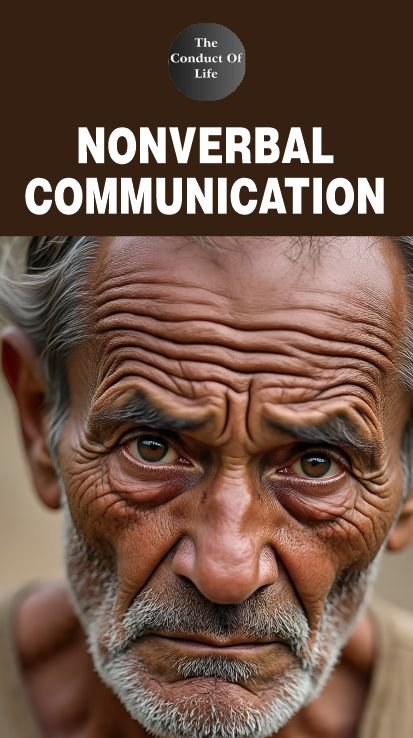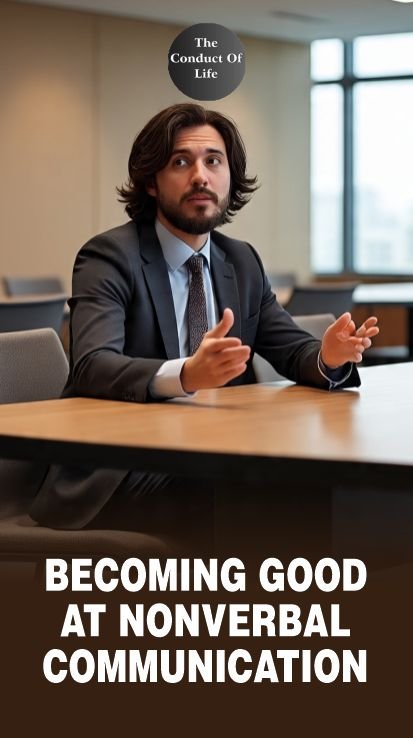Last updated on December 7th, 2025 at 07:14 pm
Nonverbal communication shapes human connection. Master the art of reading social cues and body language to understand emotions, intentions, and unspoken messages effortlessly.
Nonverbal communication shapes how you connect, influence, and build trust with others.
Every gesture, facial expression, or shift in posture speaks when words fall short.
You send and receive emotions and intentions through eye contact, tone, and movement long before you speak.
This includes social cues that reveal what people feel and body language that exposes confidence, anxiety, or sincerity.
By paying attention to these silent signals, you start to read people’s moods and respond more naturally.
A relaxed posture can invite trust, while restless gestures may tell another story.
This guide takes you deeper into the world of nonverbal communication, helping you see what people truly mean, not just what they say.
Table of Contents
- What is Nonverbal Communication – The Silent Language of Connection?
- The Core Types of Nonverbal Communication
- Reading Social Cues: The Art of Understanding Others
- Body Language: What People Say Without Words
- Importance of Nonverbal Communication in Daily Life
- How to Improve Your Nonverbal Communication Skills
- Common Mistakes in Interpreting Nonverbal Cues
- The Role of Culture in Nonverbal Communication
- Conclusion
- Frequently Asked Questions
What is Nonverbal Communication – The Silent Language of Connection?
Nonverbal communication is the exchange of messages through actions, expressions, and tone rather than words.
It includes facial expressions, gestures, posture, and the use of personal space to express emotions, attitudes, and intentions.
This silent form of communication often reveals more truth than speech, shaping how others perceive you and how effectively you connect, respond, and build trust in personal or professional interactions.
Related Posts
How to Be Respected with Body Language
When Her Body Language Says She Likes You
Body Language Attraction in Both Men and Women
How His Body Says He’s into You
6 Powerful Body Language Signals That Are Always Right
The Core Types of Nonverbal Communication
Nonverbal communication speaks through your expressions, gestures, and tone long before you say a word.
Each type sends silent signals that shape how people see and respond to you.
Mastering these signals helps you build stronger connections and express yourself clearly in any setting.
Here are the types of the silent way of communicating:
Facial Expressions
Your face reveals emotions faster and more honestly than words ever can.
A soft smile can warm hearts, while furrowed brows or tightened lips can express worry or frustration.
Every flicker of your eyes and subtle muscle movement tells a story about your mood and intent.

By observing and managing your facial cues, you can project empathy, confidence, or openness when needed.
Learning to read others’ expressions also deepens your emotional intelligence, helping you understand feelings that might never be spoken.
Your face, therefore, is your most expressive communication tool, constantly sending signals even in silence.
Gestures and Posture
Your body’s movement communicates your mindset, confidence, and openness to others.
Relaxed shoulders, open arms, and balanced gestures create a welcoming presence, while defensive postures, like crossed arms or slouching, can shut people out.

Gestures add emphasis and rhythm to your speech, making your communication engaging and dynamic.
Yet, their meanings can differ across cultures, so awareness matters.
Controlled and thoughtful gestures make you appear composed and intentional.
Standing upright, maintaining balance, and aligning your body with your words all signal confidence.
In both casual and formal settings, your posture and gestures silently define your credibility and emotional tone.
Eye Contact
Your eyes can convey trust, curiosity, and emotional connection in a single glance.
Maintaining balanced eye contact shows attentiveness and sincerity, while avoiding it may signal nervousness or disinterest.
On the other hand, excessive staring can feel dominating or uncomfortable.

The ideal eye contact is natural, warm, and responsive to the other person’s cues.
Because cultural norms vary, sensitivity to context is crucial. Your gaze should reflect engagement rather than control.
Whether you’re speaking or listening, your eyes can build an unspoken bridge, reinforcing your words with authenticity and human connection that no sentence can fully capture.
Tone and Voice (Paralanguage)
Your tone carries emotional weight beyond the meaning of your words.
The pitch, pace, and volume of your speech reveal confidence, irritation, enthusiasm, or calmness.
A gentle tone encourages openness, while a rushed or harsh one can create distance.
Paying attention to how you sound helps you align your emotions with your message.
Pauses, rhythm, and vocal warmth enhance clarity and sincerity.
Even silence, when intentional, can strengthen communication.
By mastering your paralanguage, you guide how others perceive your words, turning ordinary speech into meaningful expression that resonates deeply with listeners beyond mere vocabulary.
Touch and Personal Space
Touch and space form invisible boundaries that shape comfort and connection.
A handshake can express confidence, while a brief supportive touch conveys empathy.
Yet, inappropriate or poorly timed contact can feel intrusive.

Similarly, how close you stand affects how others feel around you, too near can invade privacy, while too far can seem detached.
These preferences differ across cultures and relationships, so awareness is key.
Respecting personal boundaries while using appropriate touch communicates care, trust, and understanding.
The art lies in balancing warmth with respect, knowing when closeness comforts and when distance maintains dignity.
Appearance and Style
Your appearance is the first nonverbal statement you make to the world.
The way you dress, groom, and carry yourself speaks volumes about your confidence, discipline, and attention to detail.
Well-chosen clothing and neat grooming signal respect for yourself and others, while sloppy presentation can suggest carelessness or disinterest.

Your personal style doesn’t need luxury; it requires authenticity and awareness.
Whether in formal or casual settings, a composed appearance enhances credibility and approachability.
Remember, style is not vanity; it’s visual communication.
Every color, texture, and accessory you choose becomes part of your silent dialogue with the world.
Reading Social Cues: The Art of Understanding Others
Social cues are the subtle signals people send through tone, facial expressions, and body movement that reveal emotions and intentions beyond words.
Learning to recognize and interpret them accurately strengthens empathy, builds emotional intelligence, and prevents misunderstandings.
Since these cues differ across cultures, awareness and context are vital.
Paying attention to tone changes, pauses, or shifts in posture helps you understand what others truly mean, even when they’re silent.
For a deeper guide on how to interpret, respond to, and improve your ability to read these silent signals, visit the full post: Reading Social Cues: The Art of Understanding Others.

Body Language: What People Say Without Words
Body language expresses your emotions and intentions without a single word.
It includes gestures, facial expressions, eye contact, and posture, all of which reveal what you truly feel.
A confident stance or relaxed posture can project openness, while slouched shoulders or crossed arms might show hesitation or defensiveness.
Even subtle expressions, like a quick smile or raised eyebrow, send powerful signals.
Cultural context also shapes interpretation, so awareness matters.
By becoming conscious of how you move and express yourself, you can communicate with clarity and confidence.
For a deeper guide, visit Body Language: What People Say Without Words.
Importance of Nonverbal Communication in Daily Life
From personal moments to professional meetings, your body language, expressions, and tone speak volumes before any words are exchanged.
Personal Relationships
In your relationships, nonverbal cues help build emotional closeness and trust.
A gentle touch, a reassuring smile, or steady eye contact can communicate care and empathy more clearly than words.
When you notice a friend’s tired eyes or folded arms, you can sense their mood and respond with kindness.
Reading these unspoken signs strengthens your connection and helps you support others naturally.
Workplace Communication
At work, nonverbal communication plays a major role in teamwork and leadership.
The way you stand, look, and listen affects how people perceive your confidence and credibility.
During meetings, open gestures and engaged posture show respect and attention, creating a cooperative atmosphere.
Leaders who use expressive yet calm body language inspire confidence, while colleagues who can read silent signals promote smoother collaboration and mutual understanding.
Social Interactions
Your presence in social settings is defined by how you carry yourself.
A firm handshake, upright posture, and attentive gaze project confidence and openness.
These subtle cues draw people in and help conversations flow more easily.
When you control your nonverbal signals and read those of others, you build stronger social awareness and connection.
Mastering these skills makes every interaction feel more natural and engaging.

How to Improve Your Nonverbal Communication Skills
Improving your nonverbal communication helps you express yourself clearly and connect with others on a deeper level.
Every gesture, movement, and tone tells a story about your thoughts and emotions.
Be More Observant
Pay attention to how people move, smile, or react during conversations.
When you observe, you notice details that words might miss.
A raised eyebrow, a sigh, or a shift in posture can reveal feelings that aren’t spoken.
By being mindful of both your own and others’ nonverbal signals, you build awareness that makes every interaction more meaningful.
Practice Self-Awareness
Record yourself speaking or engaging in a casual conversation.
Watch your body movements, facial expressions, and tone of voice.
You might notice habits like fidgeting, crossed arms, or lack of eye contact.
Adjusting these small details can make a big difference in how people perceive you. Honest feedback from trusted friends also helps refine your body language naturally.
Listen Actively
When you listen with your full attention, your nonverbal cues naturally align with the conversation.
Nod to show engagement, keep an open posture, and use gentle expressions that signal empathy.
Active listening builds trust and comfort, showing the other person that you value what they say and feel.
Mirror with Subtlety
Mirroring is a powerful way to build connection.
When you subtly match someone’s posture, gestures, or tone, it creates a feeling of comfort and understanding.
The key is subtlety; too much can seem forced.
Done right, it helps conversations feel effortless and genuine.
Learn Cultural Contexts
Nonverbal communication is not universal. A gesture or expression that feels natural to you may mean something entirely different to someone from another culture.
Taking time to learn cultural norms and showing respect for those differences prevents miscommunication and shows social awareness.
Build Empathy and Emotional Awareness
Empathy helps you sense the emotions behind someone’s words.
When you read the emotions in their eyes or tone, you respond with warmth and understanding.
Developing this awareness not only strengthens your relationships but also makes your nonverbal communication more authentic and aligned with your intentions.
Common Mistakes in Interpreting Nonverbal Cues
Misreading nonverbal cues can easily create confusion and tension in your interactions.
The key to improving your accuracy lies in awareness; knowing where interpretation goes wrong helps you read people more clearly.
Overanalyzing Nonverbal Signals
It is easy to fall into the trap of overthinking every movement or facial expression.
You might see a crossed arm and assume defensiveness when the person is simply cold.
When you overanalyze, you focus on isolated actions instead of the whole picture.
Always consider mood, environment, and conversation flow before concluding.
Ignoring Cultural and Situational Differences
What feels friendly in one culture might seem inappropriate in another.
A gesture, smile, or amount of eye contact varies widely around the world.
Even within the same culture, behavior changes with setting; a job interview differs from a casual chat.
When you account for these variations, you prevent misunderstandings and communicate with respect.
Focusing on One Cue Instead of the Whole Message
Relying on a single nonverbal cue can lead you astray.
A smile can hide discomfort, just as silence can mean thoughtfulness or disapproval.
Nonverbal communication works as a blend; facial expressions, tone, and body language all combine to form meaning.
Reading all signals together gives you a more accurate understanding of what someone truly feels.
Missing Inconsistencies Between Verbal and Nonverbal Signals
Sometimes what people say does not match how they act.
A person might say “I’m fine” while avoiding eye contact or fidgeting.
When verbal and nonverbal messages clash, it usually means there’s more to the story.
Paying attention to such mismatches helps you detect unspoken emotions and respond with empathy.
Assuming Universality in Body Language
It is a mistake to believe body language has the same meaning for everyone.
Personality, mood, and even upbringing affect how people express themselves.
Some people naturally gesture more; others stay still. Avoid making instant judgments based on your expectations.
Stay curious, observe patterns, and let context guide your interpretation.
The Role of Culture in Nonverbal Communication
Culture shapes how you express emotions, show respect, and interpret the actions of others.
Every gesture, movement, or glance carries a different meaning depending on cultural context and background.
Gestures Mean Different Things Across Cultures
A single hand movement can create a connection or cause offense, depending on where you are.
For example, the thumbs-up gesture is positive in some countries but rude in others.
Even a nod can confuse communication; what signals agreement in one culture might only mean acknowledgment in another.
Learning these differences keeps your interactions respectful and prevents unnecessary tension.
Personal Space Reflects Cultural Comfort
The space you keep between yourself and others speaks volumes.
In many Western countries, people prefer a wider personal distance, while others, like those in Latin America or the Middle East, feel at ease standing closer.
If you move too close or too far from someone, it can unintentionally send the wrong message.
Respecting spatial preferences shows awareness and consideration.
Eye Contact Carries Different Meanings
The way you use your eyes says a lot about how you relate to others.
In some cultures, steady eye contact shows confidence and sincerity.
In others, it may seem rude or aggressive. Knowing when to hold someone’s gaze and when to look away helps you build trust without crossing boundaries.
Facial Expressions and Emotional Display
While smiles and frowns are universal, the way emotions are expressed varies.
Some cultures value emotional restraint, while others encourage open expression.
A smile might signal friendliness in one setting but discomfort in another.
Paying attention to how emotions are displayed helps you interpret reactions more accurately and respond with sensitivity.
Adapting to Cultural Differences Builds Connection
Cultural awareness makes communication smoother and more authentic.
When you take time to learn how gestures, posture, and eye contact differ, you show respect and openness.
Adapting to these nuances allows you to connect with people from diverse backgrounds, build stronger relationships, and avoid miscommunication in personal and professional interactions.
Conclusion
Nonverbal communication speaks the loudest when words fall short.
Every glance, movement, and tone you express carries meaning that shapes how others feel about you.
When you pay attention to these silent cues, you start to understand emotions that words cannot explain.
From your posture in a meeting to the look in your eyes during a conversation, small signals define trust, warmth, and connection.
The more aware you become, the clearer your relationships and interactions will feel.
Start observing, adjusting, and practicing, because mastering nonverbal communication is the key to expressing what truly matters.
Frequently Asked Questions
What are the main types of nonverbal communication?
Facial expressions, gestures, posture, tone of voice, touch, personal space, and appearance are key forms of nonverbal communication that reveal emotions and intentions.
How does culture affect nonverbal communication?
Cultural background shapes how gestures, eye contact, and personal space are used. What’s polite or expressive in one culture may seem rude in another.
Can nonverbal communication be more powerful than words?
Yes. Nonverbal signals like tone, facial expression, and movement reveal emotions more truthfully than words and often determine how your message is received.
How can I improve my nonverbal communication skills?
Stay aware of your body language, tone, and facial expressions. Observe others, maintain an open posture, and align your actions with your true feelings.
References
- How to Read Nonverbal Communication Cues: 5 Techniques
- 9 Types of Nonverbal Communication
- How Much of Communication Is Nonverbal?
Pious Clements is the insightful voice behind "The Conducts of Life" blog, where he writes about life ethics, self-development, life mastery, and the dynamics of people and society.
With a profound understanding of human behaviuor and societal dynamics, Pious offers thought-provoking perspectives on ethical living and personal growth.
Through engaging narratives and astute observations, he inspires readers to navigate life's complexities with wisdom and integrity, encouraging a deeper understanding of the human experience and our place within society.
